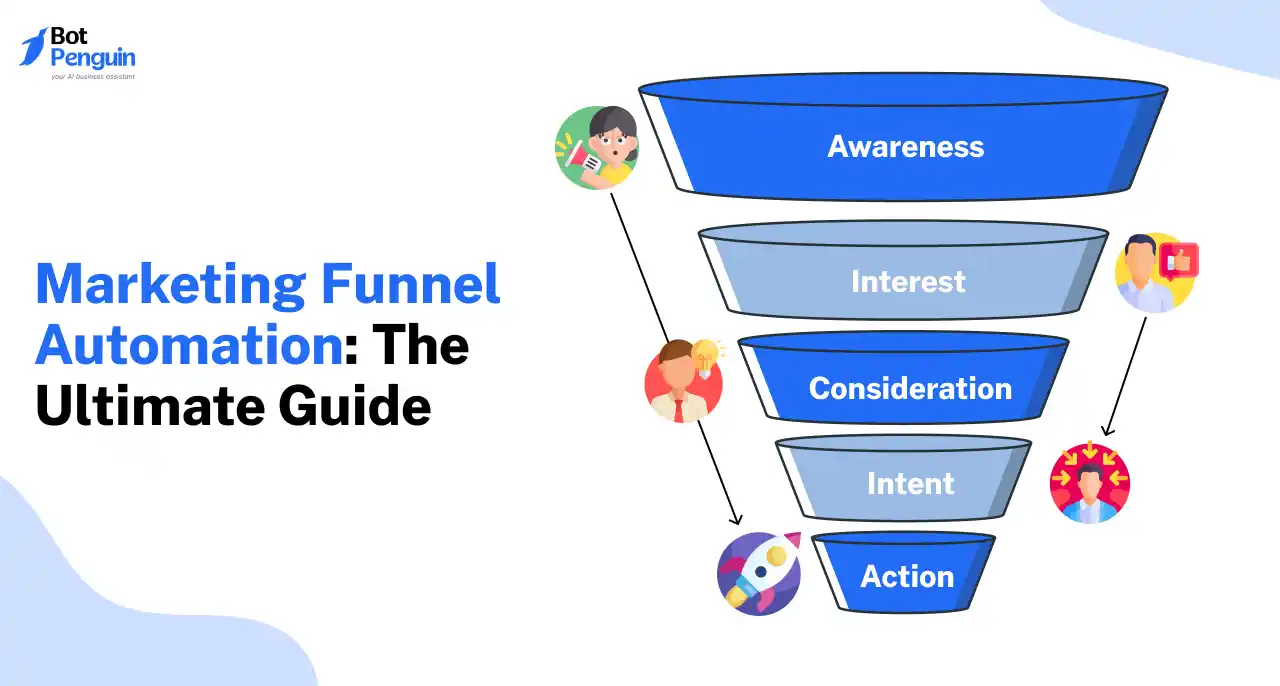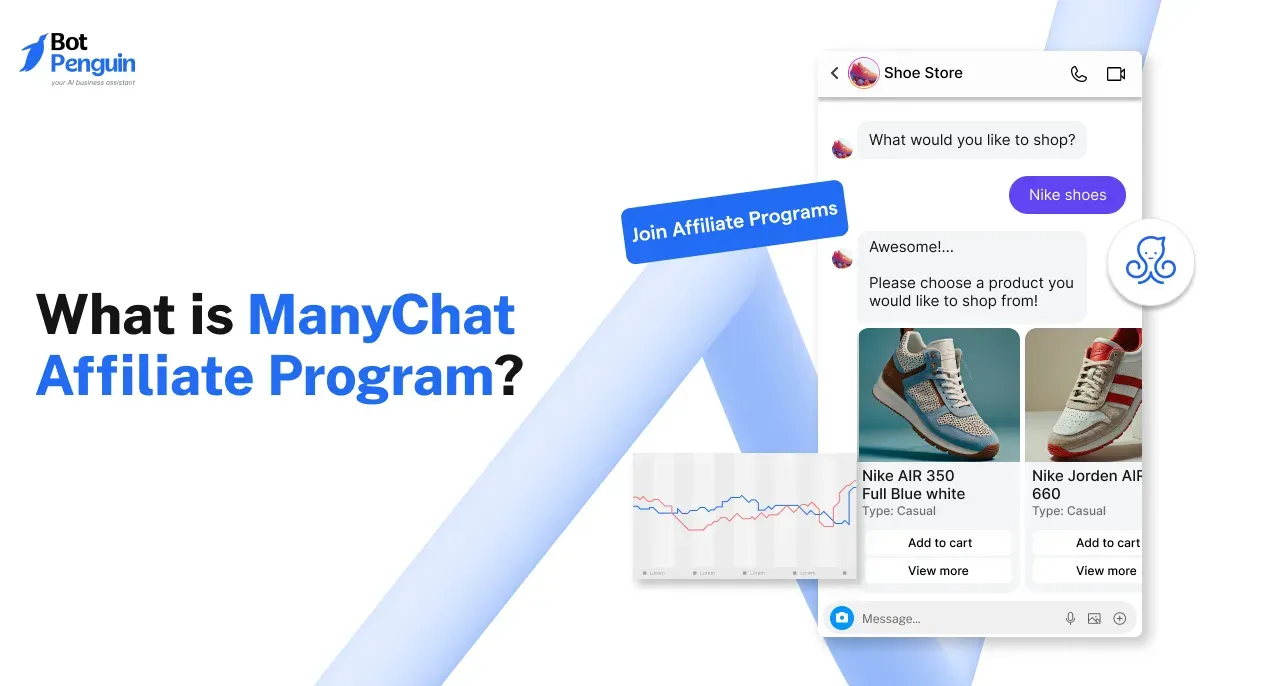Introduction
Marketing funnel automation is a boon to marketers. It helps turn leads into actual customers.
According to HubSpot's 2024 State of Marketing Report, companies implementing marketing automation strategies have seen a remarkable 451% increase in qualified leads, while reducing marketing overhead by 12.2%.
A recent study by Salesforce reveals that 76% of businesses using chatbots for marketing report achieving their ROI goals within the first year of implementation.
Using marketing automation can make your marketing efforts more effective. This is because when you automate marketing, you can generate leads regularly, convert them, and collect information to find out about the best strategies you can follow.
Also, marketing funnel automation has now become a necessity, which allows your businesses to deliver personalized experiences at scale.
This article will provide detailed information on marketing funnel automation, its best practices, and strategies, and will also be your roadmap to success.
However, before proceeding, let us know what a marketing funnel is.
What is a Marketing Funnel?
A marketing funnel shows your customers' entire journey, from knowing your brand to the end when they purchase your products or services.

It is important to pay good attention to your marketing funnel. This helps you understand your customers’ preferences and what convinces them to buy your products.
Hence, you can increase your sales, retain customers, and increase conversion rates. With a proper marketing funnel, you can easily get new leads.
What is Marketing Funnel Automation?
Marketing funnel automation is a process that helps you get new leads automatically. Several entities like content, advertisements, etc. combine to generate leads without manual interference.
It lets you know the path your customers take from the beginning to the end. The first stage is where your customers get awareness of your brand.
The next stages may involve them gaining an interest in it, developing a relationship, and ending up doing the call to action (CTA). The CTA may be either signing up, contacting you, or even a purchase.
In simple words, marketing funnel automation lets your businesses meet your customers’ personalized needs and preferences. It helps you to provide them with the necessary information they require at the appropriate time.
The marketing automation process also ensures that each lead is nurtured effectively, allowing your businesses to focus on other critical tasks.
Let us now explore the various stages involved in automating the marketing funnel and how they work together to drive success.
Stages of Marketing Funnel Automation
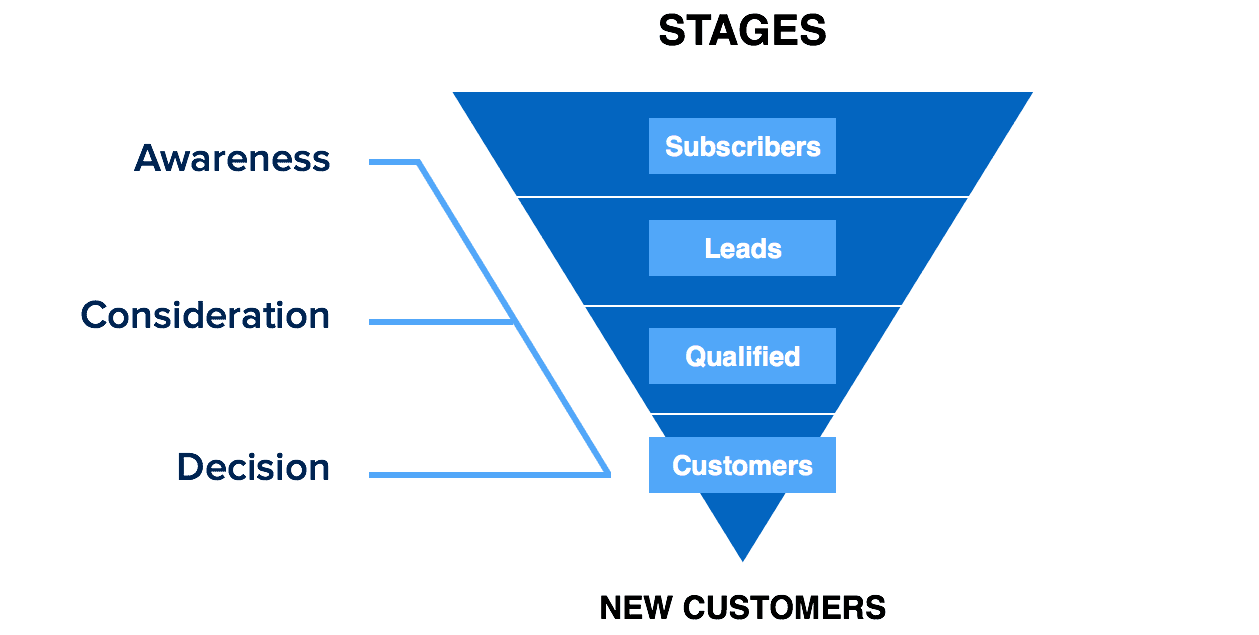
There are different stages involved in marketing funnel automation. You have to understand well about these stages to implement good marketing automation strategies.
Each stage is very important in converting these leads into customers. The various stages include Awareness, Interest, Consideration, and Conversion. Let us elaborate on these stages.
Awareness
You can consider the awareness stage as the entry point of your funnel. This is where people will come to know about your brand, services, or products.
Now is the right time for you to introduce effective marketing automation strategies to grab their attention, and spike their interest in your product. A few of these strategies are explained below.
- Content Marketing: This strategy can be very effective. You can use automated tools to create and schedule social media posts, emails, or post blogs, and videos that match the preferences of your potential customers and turn their attention toward your businesses.
- Chatbot for Marketing: Another successful strategy you can use is chatbot for marketing. You can see almost all businesses have a chatbot on their websites for answering customer queries and guiding them to relevant resources.
Interest
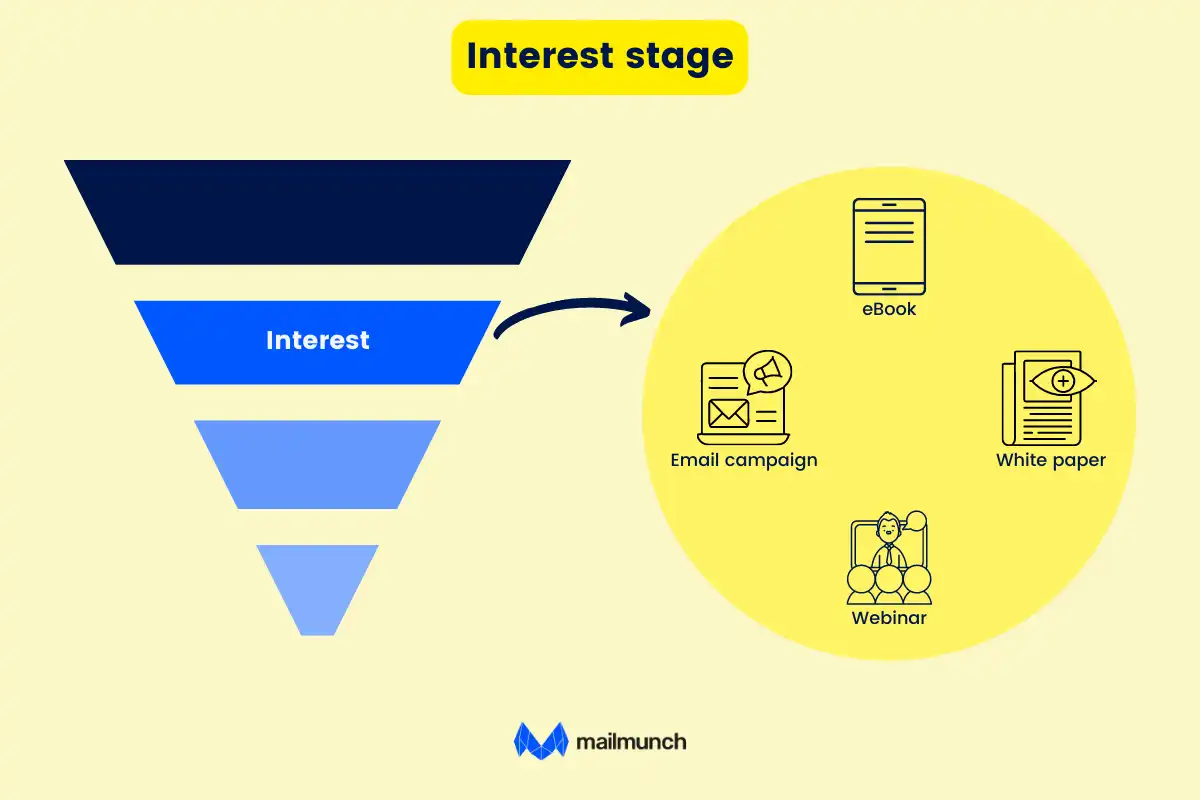
This stage is where your potential customers have noticed your products or services and are showing interest in them. It means they have also progressed down the funnel from the top.
You can use marketing funnel automation at this point to provide personalized recommendations, keep them hooked on your products, and allow them to explore more.
A few effective marketing automation strategies to follow are given below.
- Email Marketing: This strategy is widely preferred in marketing automation. It is less time-consuming.
You can send automated emails that are personalized according to your customers’ needs, and offer them a promotion as part of welcoming them on their first visit.
These steps can convince them to consider buying your products or services.
- Lead Magnets: This strategy is also effective. Now that your customers have expressed interest in your products, you can provide them with free ebooks, extra discounts, and a free demo to encourage them to explore your products further. You can generate more leads with this process.
Consideration
In this stage, potential customers evaluate your products or services to check if they satisfy their needs. They might even compare with other competitors, search for reviews, and testimonials, and may request more details from you if required.
When you use marketing automation at this time, you can give them the required information in the form of demos, or customer reviews and convince them to make a positive decision towards buying your products.
A few effective marketing strategies you can consider are elaborated below.
- Product Demos and Webinars: You can send automated invitations for product demos or webinars to leads who have shown interest.
This helps you to provide in-depth information and there is no need for a manual follow-up.
- Testimonials and Customer Reviews: When your leads are considering buying your products, the best way to convince them is by providing testimonials and reviews of people who have already used and are satisfied with your products. This can increase the confidence of your leads about your products.
- Retargeting Ads: You can send automated retargeting ads to remind your potential leads of your offerings as they browse other websites.
This will remind them of your brand and consider it a priority during the decision-making process.
Conversion
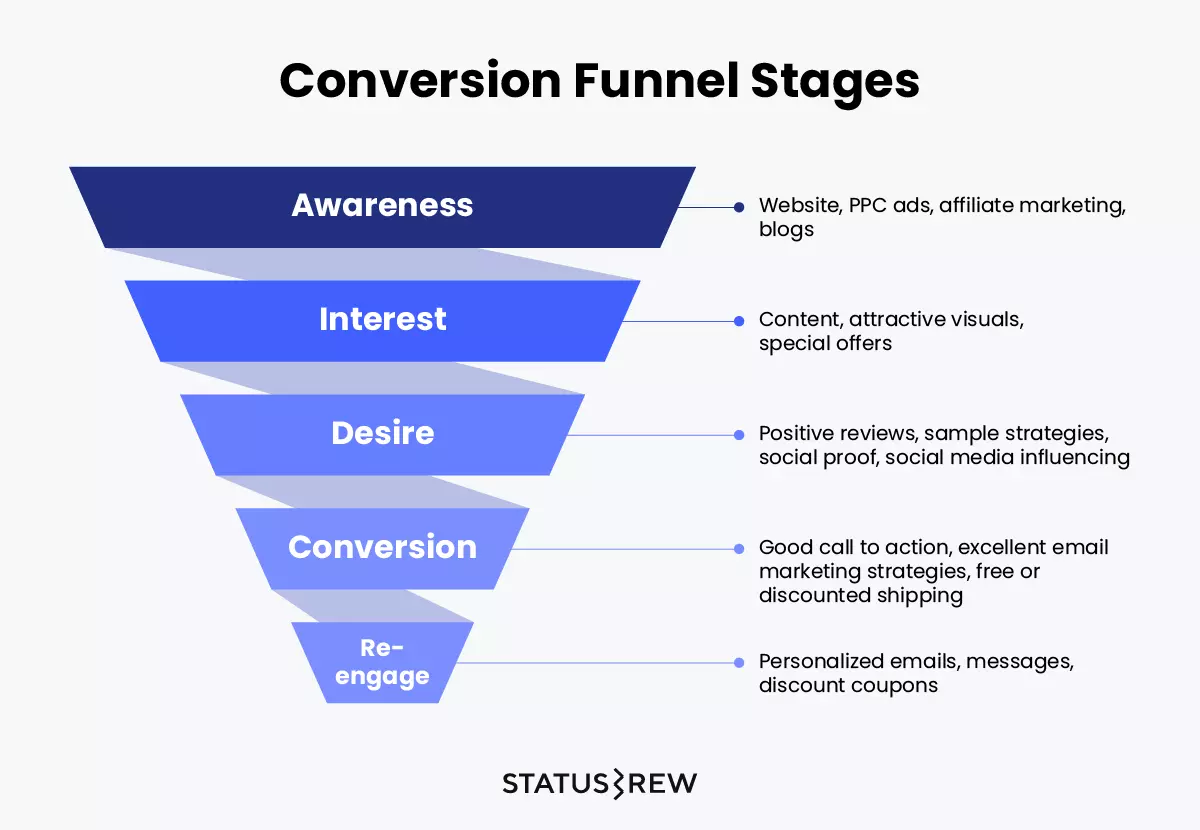
This is the stage where your customers have reached the bottom of the funnel. They would have decided to purchase your products or services. You have to turn them into paying customers.
Marketing automation can help you greatly with this process. It can simplify the process and allow the customers to buy your products easily. A few useful marketing strategies you can implement are given below.
- Offer Limited Time Discounts: When you offer discounts, customers may find it appealing and might turn into paying customers.
You can make it even more exciting if you set a time limit for your offers or discounts. It will make the customers take immediate action.
- User-Friendly Process: Customers prefer simple processes while purchasing products. So, provide clear instructions and easy steps while they buy your products.
You can even enable auto-fill options for the basic fields which can save time for customers.
Benefits of Marketing Funnel Automation
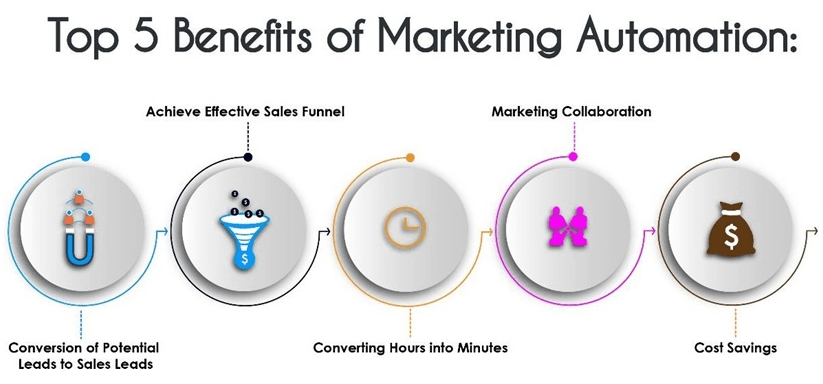
Marketing funnel automation offers numerous advantages with which you can manage your sales processes effectively.
When you automate repetitive tasks and use chatbots for basic customer interactions, you can save time and resources and concentrate on growing your business.
Let us consider the major benefits of implementing marketing funnel automation and how it can strengthen your marketing efforts.
Saves Time and Resources
When you use marketing funnel automation in your businesses, it saves time and resources. You can automate repetitive tasks, such as sending emails, posting content on social media, and managing leads. Hence, your teams can focus on more important and strategic initiatives.
- Automate Email Campaigns: Instead of manually sending emails to every lead, you can automate the process.
This helps to send personalized messages based on triggers, such as signing up for a newsletter. Hence, you can provide timely communication to your leads.
- Schedule Social Media Posts: You can automate social media posts with the help of tools. It helps you maintain a consistent online presence without requiring constant attention.
You can schedule posts in advance, and concentrate on other important tasks.
Consider a marketing team that uses automation to handle these routine tasks. They can now focus on developing new marketing automation strategies that allow them to generate more innovative campaigns and achieve better overall results.
Improves Lead Nurturing

You have to nurture leads effectively to turn prospects into customers. When you use marketing funnel automation, it enhances this process by ensuring that each lead receives the right message at the right time.
- Personalized Content Delivery: When you use automation tools, they can classify leads based on their behavior and interests, and send personalized content according to their needs. This keeps them hooked and moving through the funnel.
- Lead Scoring and Follow-Up: When you use automated lead scoring systems, they help prioritize leads based on their likelihood to convert.
Sales teams can then focus their efforts on high-value prospects, improving the chances of conversion.
Enhances Customer Experience
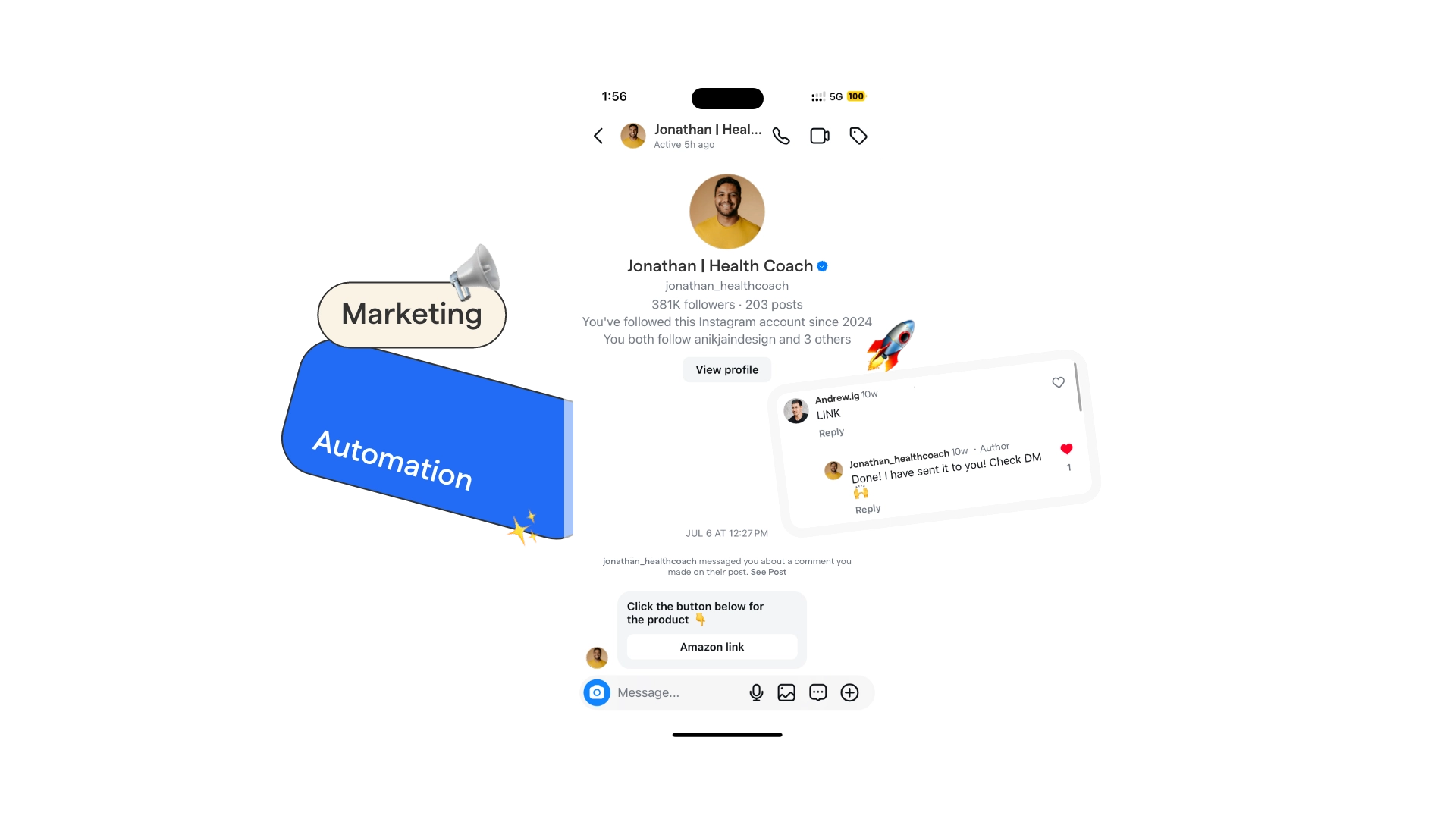
Customers love simple processes and user-friendly interfaces. Marketing funnel automation helps create personalized experiences that resonate with customers.
- Consistent Communication: When you use automated systems, they ensure that customers receive consistent and timely communication, whether it's through email, social media, or chatbots. This builds trust and strengthens relationships.
- Chatbot for Marketing: When you use a chatbot for marketing, it can provide instant responses to customer inquiries, offering support 24/7. This helps the customers to get quick and accurate information.
Increases Conversion Rates
Marketing funnel automation is very important to increase conversion rates. It sends personalized messages to the right customers at the right time.
- Retargeting Campaigns: You can use automation tools to set up retargeting campaigns that reach out to leads who have shown interest, but have not yet converted.
These timely reminders can greatly influence them to purchase your products or services.
- A/B Testing: You can use automated systems to run A/B tests on various marketing elements, such as email subject lines or landing pages, and find the best marketing strategies.
This data-driven approach helps you run good campaigns and increase conversion rates.
Real-Time Data and Analytics
When you have access to real-time data and analytics, you can make informed decisions. Marketing funnel automation provides you with valuable insights that can guide in marketing strategies.
- Performance Tracking: Automated tools allow you to track the performance of your marketing campaigns in real-time, and will provide insights into what’s working and what’s not. Based on this data, you can tweak or adjust your strategies.
- Customer Behavior Analysis: Automation tools allow you to analyze customer behavior, and you can understand how customers interact with your brand.
This information can be used to improve marketing automation strategies and make them more effective.
Types of Marketing Funnel Automation
There are different types of marketing funnel automation available, and you have to understand these types to use them effectively.
Each one is unique, and it helps your businesses to automate various aspects of your marketing efforts.
Lead Generation Automation
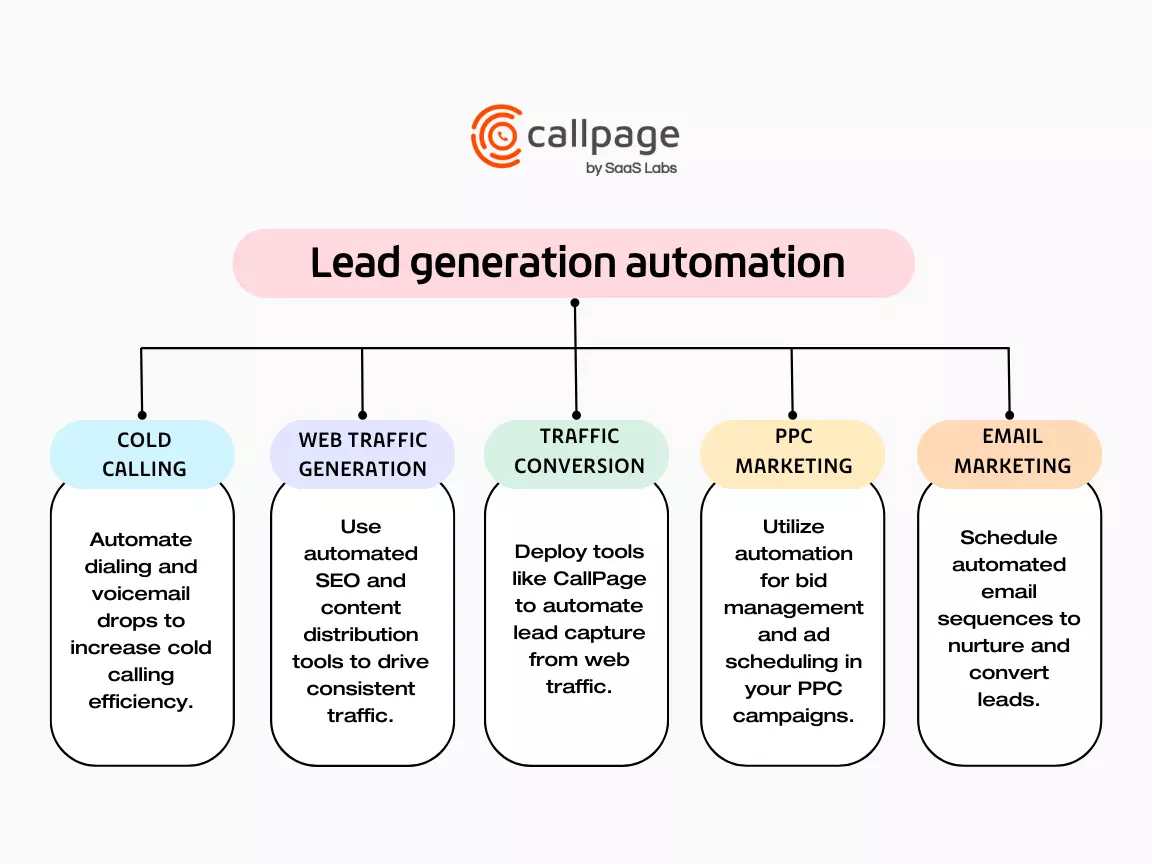
Lead generation is the first step in the marketing funnel. When you automate this process, you can capture leads efficiently and avoid missing any potential customers.
- Automated Forms and Landing Pages: You can use tools to automate form submissions and landing pages. This can help you capture leads without much difficulty.
These leads are then automatically added to your CRM or email list for further nurturing.
- Pop-Ups and Lead Magnets: You can grab the attention of customers visiting your website with the help of automated pop-ups and lead magnets.
Also, encourage them to leave their contact information in exchange for valuable content.
Email Marketing Automation
This strategy is one of the most efficient ways to nurture leads. When you automate email campaigns, it helps in timely and relevant communication.
- Drip Campaigns: Automated drip campaigns send a series of emails to leads who have shown interest or visited your products or services and guide them through the marketing funnel. You can tailor these emails according to the lead’s behavior and preferences.
- Behavioral Triggers: You can send triggered emails based on specific actions of your leads, such as downloading a whitepaper or attending a webinar.
This ensures that leads receive relevant content when they are most engaged.
Social Media Automation
You have to remain active on social media to make your brand reach a wider audience. You can automate social media activities to maintain consistent engagement with your audience.
- Scheduled Posts: You can use automated tools to schedule social media posts in advance, which allows for a steady stream of content.
This helps maintain brand awareness without requiring constant attention.
- Social Listening and Engagement: You can use automation tools to track social media platforms for any mentions of your brand.
If anything is found, it provides timely responses to customer inquiries or feedback.
CRM Integration

When you integrate your CRM with marketing automation tools, they help streamline lead management. Hence, sales teams can have the information they need to close deals.
- Automated Lead Assignment: This process allows leads to be automatically assigned to sales representatives based on predefined criteria, such as location or industry.
This ensures that leads are handled promptly and by the right person.
- Customer Data Synchronization: When you automate the synchronization of customer data between your CRM and marketing tools, it allows all teams to have access to up-to-date information.
Chatbots and Their Role in Marketing Funnel Automation
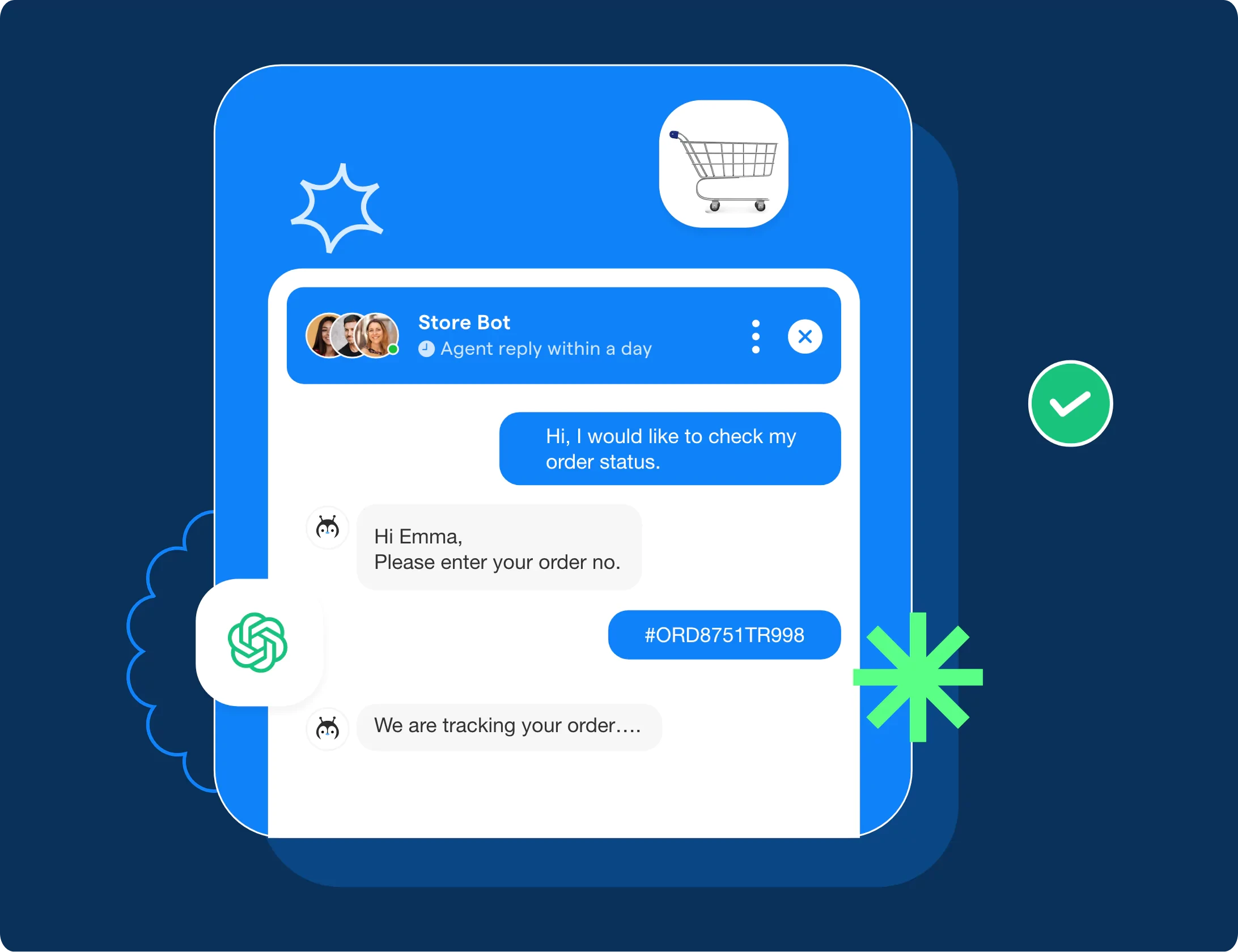
When you use chatbots for marketing, they automate customer interactions providing instant support round-the-clock and guiding leads through the funnel.
- Lead Qualification: Chatbots can ask basic relevant questions to customers and determine if they are potential leads. Once confirmed, they can then be directed to the sales team or added to the CRM for further nurturing.
- 24/7 Customer Support: Chatbots provide round-the-clock support, answering common questions and providing information even when your team is unavailable.
Strategies of Marketing Funnel Automation
To get the best results from marketing funnel automation, it’s essential to implement effective strategies that align with your business goals. Let us consider them.
- Define Your Goals: You have to be clear with your goals before automating your marketing funnel. Your goal can be anything from increasing lead generation to improving customer retention.
- Define Who Your Target Audience Is: You have to know your audience well to use the marketing automation funnel effectively.
Automation tools allow you to classify your audience based on behavior, demographics, and other criteria. This can help you run more targeted and effective marketing campaigns.
- Test and Optimize: You have to continuously test and optimize your automated processes. Whether it’s A/B testing email subject lines or adjusting lead scoring criteria, you have to optimize according to the requirements to be successful.
- Integrate Your Tools: You have to ensure that all your marketing tools are integrated, from your CRM to your email marketing platform.
This enables a seamless flow of data and consistent communication across channels.
- Focus on Customer Experience: You can use automation to improve customer experience. When you send personalized and timely communication, it can improve customer satisfaction and loyalty.
Best Practices for a Successful Marketing Automation Funnel
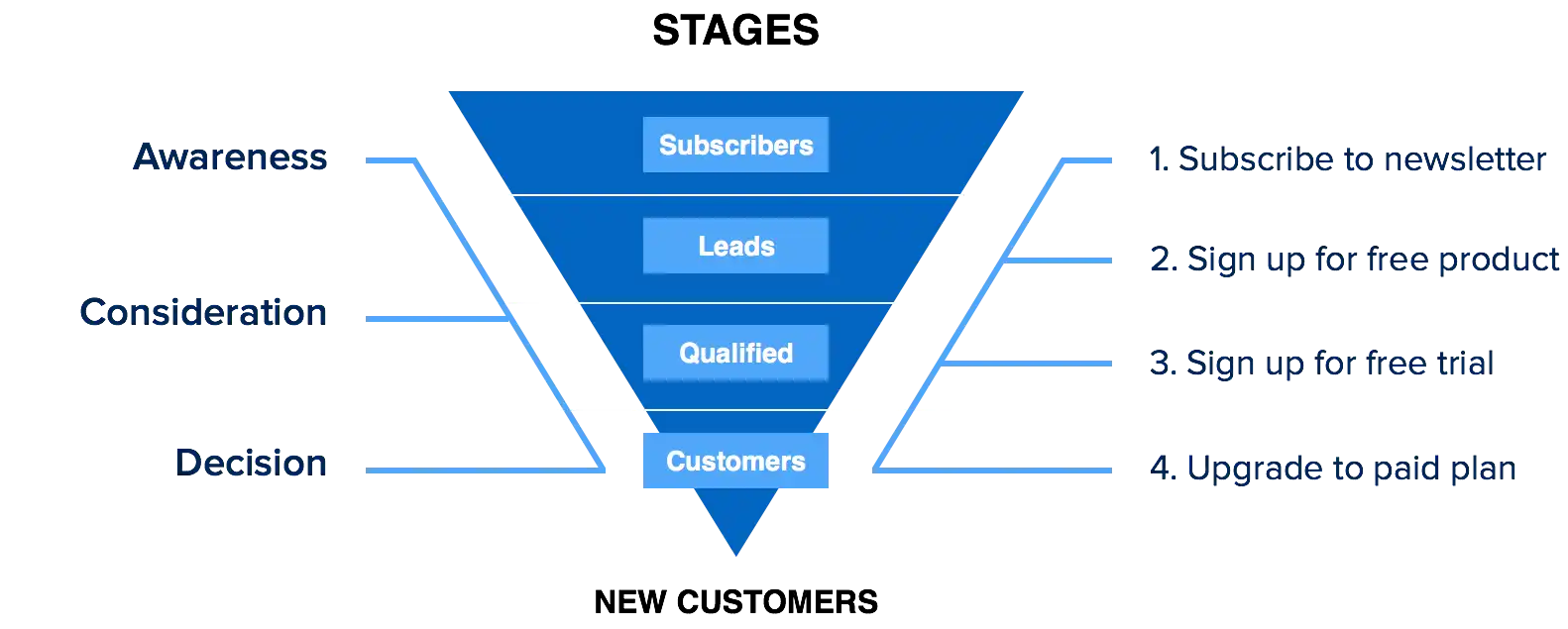
You can develop a successful marketing automation funnel through the best marketing automation strategies, implementing, and continuously optimizing them.
To ensure your automated funnel delivers the best results, it's important to follow key marketing automation best practices.
These practices help you increase efficiency, improve customer engagement, and drive conversions. Let us examine the steps involved.
Choose Appropriate Tools
Choose tools that meet your requirements. Your needs can be anything from the generation of leads to increased conversion rates.
Whatever the case, your selected tools must easily integrate into your existing systems. You should also ensure that your tools are user-friendly for your customers to have a good experience.
- Personalization: Your automation processes should meet your business requirements. You can personalize them and attain your goals.
Understand Your Audience
Before automating your funnel, take the time to deeply understand your audience. When you know their needs, pain points, and behaviors, you can create content and messaging that addresses all these criteria.
- Customer Personas: You can develop detailed customer personas containing various segments of your audiences. These personas help you create personalized marketing messages.
Classify Your Audience
Not all leads are the same. If you follow a single approach for all your leads, you can miss potential customers. So, classify your audience according to their preferences to deliver more relevant and personalized content.
- Behavior-Based Segmentation: Group your audience based on their interactions with your brand, such as email opens, website visits, or purchases. This allows you to send more personalized and effective messages.
Focus on Quality Content
Quality content is important to make a successful marketing funnel automation strategy. When you create high-quality content, it attracts, engages, and converts leads.
- Educational and Engaging Content: Provide content that educates and engages your audience, such as blog posts, videos, or infographics. This helps the customers to trust your brand more.
Use Data to Make Informed Decisions
Data should be the driving force of your marketing automation strategies. You should regularly analyze performances to understand what’s working and where improvements are needed.
- A/B Testing: Continuously test different elements of your campaigns, such as email subject lines or landing page designs. Use the results to fine-tune and improve your strategies.
Automate Personalized Experiences
With automation, you can deliver personalized experiences to your leads or customers. You can send tailored messages to all your leads according to their preferences.
- Personalized Email Sequences: Set up automated email sequences that adapt based on a lead's actions. This can help maintain relevant communication and keep them engaged. Hence, the chances of their conversion can increase greatly.
Regularly Review and Optimize
Automation is not something that you can fix and let it work by itself. You have to frequently review and optimize your funnel to ensure it remains effective.
- Perform Audits: Conduct regular audits of your automated marketing campaigns to identify areas for improvement. Make necessary adjustments to enhance performance.
Conclusion
We have reached the end of this comprehensive guide, and you can confidently conclude that marketing funnel automation is here to stay.
When you implement the best marketing automation strategies, you can boost your conversion rates and also offer a pleasant customer experience.
You should also constantly monitor and optimize your automation according to the requirements. When you follow the marketing automation best practices, you can deliver the right message at the right time while also maintaining a good relationship with your audience.
Whether you are using chatbots for marketing or implementing automated drip campaigns, they should meet your overall business objectives.
By using marketing funnel automation today, you're not just streamlining operations – you're also increasing the growth of your business.
Frequently Asked Questions (FAQs)
What is marketing funnel automation?
Marketing funnel automation is a process that helps you get new leads automatically. It lets you know the path your customers take from the beginning to the end.
The first stage is where your customers get introduced to your brand. The next stages may involve them gaining an interest in it, developing a relationship, and ending up doing the call to action (CTA).
How does marketing funnel automation improve lead nurturing?
Marketing funnel automation improves lead nurturing by delivering personalized content based on user behavior, automating follow-ups, and scoring leads, which helps prioritize high-value prospects and ensures consistent communication throughout the customer journey.
What are the major benefits of marketing funnel automation?
The major benefits of marketing funnel automation include saving time and resources, improving lead nurturing, improving customer experience, increasing conversion rates, and providing real-time data and analytics to guide decision-making and optimize marketing strategies.
How can you segment your audience in marketing funnel automation?
You can segment your audience in marketing funnel automation by categorizing leads based on behavior, demographics, or interactions with your brand.
This allows for more personalized and effective marketing messages that they can easily relate to.
What role do chatbots play in marketing funnel automation?
Chatbots in marketing funnel automation provide instant responses to customer inquiries, qualify leads, offer 24/7 support, and guide prospects through the funnel, improving engagement and increasing the likelihood of conversion.
How can you optimize a marketing funnel automation strategy?
Optimizing a marketing funnel automation strategy involves regularly reviewing campaign performance, A/B testing elements, refining audience segmentation, and using data-driven insights to adjust tactics, ensuring ongoing effectiveness and alignment with business goals.
